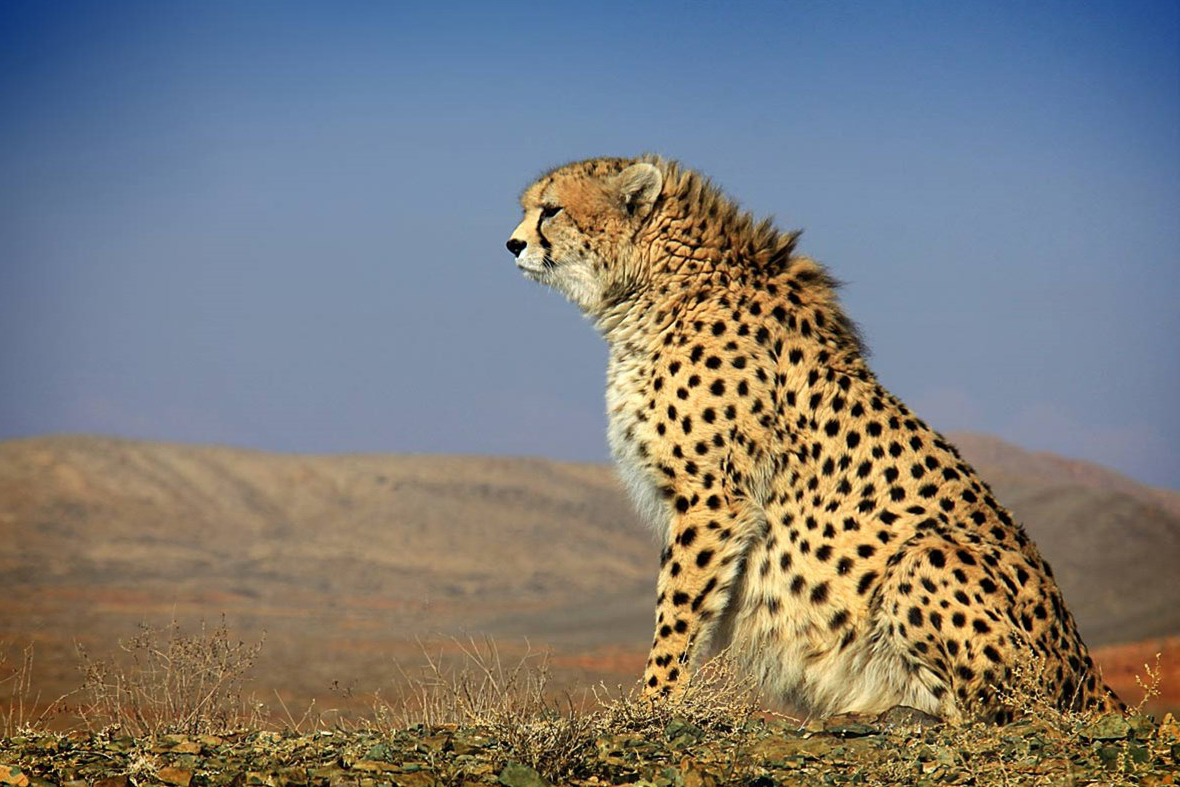Looking for a waterhole to quench her cubs’ thirst, a female cheetah led her three offspring to the palm groves around the quiet town of Bafq in Yazd Province on a hot summer day in 1995.
But they never got there.
Surrounded by terrified locals equipped with sticks and stones, the cheetah’s maternal instincts kicked in and she prepared to defend her cubs against the merciless onslaught of people who were ignorant of the plight of the rare animals they were about to attack.
Battered and bruised, the cheetah was chased away and forced to abandon her cubs after a valiant fight to defend them.
A Bafq resident who witnessed the ordeal got in touch with the local office of the Department of Environment, which dispatched a team to investigate the incident and recover the three cubs.
They found the lifeless body of one of the cubs but to their relief the other two were still breathing—barely. However, one of the surviving cubs died on route to the provincial capital Yazd due to the severity of its wounds, while the only remaining cub—which was later named Marita—lived alone in Tehran’s Pardisan Park until her death at the age of nine.
According to local park rangers, the mother returned to the area searching for her cubs for an entire week before losing hope and giving up.
The senseless attack on the critically endangered cheetah and her three cubs happened on this day 21 years ago, prompting calls led by the Iranian Cheetah Association to designate August 30 the National Asiatic Cheetah Day. Their wish was finally granted in 2007.
Human Avarice and Other Threats
The only cheetah subspecies found in Asia, the Asiatic cheetah is now confined to Iran (hence the name Iranian cheetah) where it numbers at about 50; a tenth of what it was less than 40 years ago.
In other words, the population of the species drops by 2% with every death. That is why the International Union for Conservation of Nature lists the Asiatic cheetah as a critically endangered species, the highest risk category assigned by the IUCN for wild species, which means it is facing the very risk of extinction in the wild.
The animal’s habitat once stretched from Saudi Arabia to the plains of Southwest Asia, but the species was driven to extinction in the 20th century.
In Iran, the cheetah’s dramatic population decline is attributed to a host of factors, including poaching, road accidents and loss of habitat of two gazelle species which it preys on.
In addition to manmade threats, the Asiatic cheetah’s survival is impacted by larger predators. Despite being fast, the cheetahs lack physical strength, rendering them vulnerable to larger animals in a face-off.
While the impact of larger predators such as Persian leopards, wolves and hyenas, which outnumber the Asiatic cheetah in Iran, is unknown, the recent death of a radio-collared cheetah by another unidentified animal suggests that the cheetah faces risks other than human avarice.
Found mainly in Iran’s vast central desert, the animal is also threatened by the country’s prolonged struggle with drought and water shortage.
Conservation Efforts
In 2001, with support from the United Nations Development Program, the Department of Environment initiated a comprehensive and ambitious long-term program, called the Conservation of the Asiatic Cheetah Project (CACP), to pull the endangered species back from the verge of extinction.
The importance of the program is highlighted by the fact that renowned breeding specialist Sean McKeown is aiding the project and is currently involved in a publicized breeding program at the CACP.
President Hassan Rouhani, who took office in 2013, has said time and again that his administration attaches great importance to protecting the environment and the life it supports.
Credit where credit is due; the administration in general and the DOE in particular have taken steps to protect the vulnerable Asiatic cheetah.
According to an infographic outlining the government’s measures to save the species made public earlier this week, the administration has replenished desiccated water holes while the DOE and Ministry of Roads and Urban Development are taking steps to make the Tehran-Mashhad road safe to cross for cheetahs.
More than 60% of all cheetah deaths in the past nine years have been caused by road accidents on that road.
In an effort to raise public awareness and sensitivity toward the species, the government has actively sought to turn the Asiatic cheetah into a national symbol. The appearance of an image of the animal on the national football team’s jersey is but one example.
Furthermore, where possible, the department has employed the help of NGOs and local residents to implement protective measures, such as in Touran Biosphere Reserve, which serves to create a connection between rural residents and their feline neighbors.
But perhaps the most publicized move to protect the animal is insuring the Asiatic cheetah. Following protracted negotiations with the DOE, the local Ma Insurance Company announced earlier this year that it would pay for damages caused by cheetahs, as well as other rare species such as the Persian leopard, in a bid to dissuade farmers, shepherds and other rural residents from taking matters into their own hands.
The sole habitat of the Asiatic cheetah, Iran has a responsibility to protect the endangered creature and do what must be done to help increase its numbers.
The Iranian cheetah is our national symbol; we must strive to save it.



